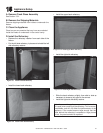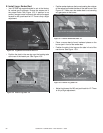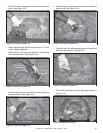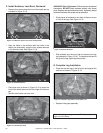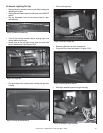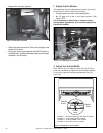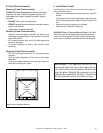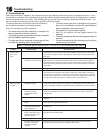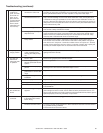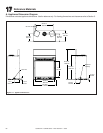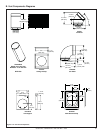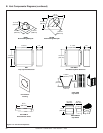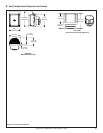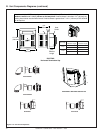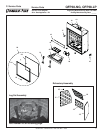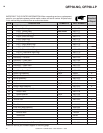
Quadra-Fire • QFP38 Series • 4061-300 Rev i • 9/09 65
Troubleshooting (continued)
3. Pilot lights but
continues to
spark, and main
burner will not
ignite. (If the
pilot continues
to spark after the
pilot fl ame has
been lit, fl ame
rectifi cation has
not occurred.)
a. A shorted or loose
connection in sensor rod.
Verify all connections to wiring diagram in manual. Verify connections underneath pilot
assembly are tight. Verify connections are not grounding out to metal chassis, pilot
burner, pilot bracket/enclosure or screen if present, or any other metal object.
b. Poor fl ame rectifi cation or
contaminated sensor rod.
Verify fl ame is engulfi ng sensor rod. If the pilot assembly does not have a ground
strap, consider installing one to increase fl ame rectifi cation. Verify correct pilot orifi ce
is installed and inlet gas specifi cations are met. Flame carries rectifi cation current, not
the gas. If fl ame lifts from pilot hood, the circuit is broken. A wrong orifi ce or too high an
inlet pressure can cause pilot fl ame to lift. The sensor rod may be contaminated. Clean
sensor rod with emery cloth.
c. Module is not grounded. Verify that module is securely grounded to metal chassis of appliance. Verify that the
wire harness is fi rmly connected to module.
d. Damaged pilot assembly or
dirty sensor rod.
Verify that ceramic insulator around the sensor rod is not cracked, damaged, or loose.
Verify connection from sensor rod to white sensor wire. Clean sensor rod with emery
cloth to remove any contaminants that may have accumulated on sensor rod. Verify
continuity with a multimeter with ohms set at lowest range.
e. Faulty module. Turn ON/OFF rocker switch or wall switch to OFF position. Remove ignitor wire “I”
from module. Place ON/OFF rocker switch or wall switch in ON position. Hold ground
wire about 3/16 in. away from “I” terminal on module. If there is no spark at “I” terminal,
module must be replaced. If there is a spark at “I” terminal, module is fi ne. Inspect pilot
assembly for shorted sdparker wire or cracked insulator around electrode.
4. Frequent pilot
outage problem.
a. Pilot fl ame may be too high
or low, or blowing (high),
causing pilot safety to drop
out.
Clean and adjust the pilot fl ame for maximum fl ame impingement on sensor. Follow
lighting instructions carefully.
5. The pilot and
main burner
extinguish while
in operation.
a. No LP in tank. Check the LP (propane) tank. Refi ll the fuel tank.
b. Inner vent pipt leaking
exhaust gases back into the
system.
Check for gas leaks.
c. Horizontal vent improperly
pitched.
The horizontal vent cap should slope down only enough to prevent any water from
entering the unit. The maximum downwards slope is 1/4 in.
d. Glass too loose and air tight
packet leaks in corners after
usage.
Tighten the corner.
e. Improper vent cap
installation.
Check for proper installation and freedom from debris or blockage.
6. Glass soots. a. Flame impingement. Adjust the log set so that the fl ame does not excessively impinge on it.
b. Improper venturi setting. Adjust the air shutter at the base of the burner.
c. Debris around venturi. Inspect the opening at the base of the burner. NO MATERIAL SHOULD BE PLACED IN
THIS OPENING.
7. Flame burns
blue and lifts off
burner.
a. Insuffi cient oxygen being
supplied.
Ensure that the vent cap is installed properly and free of debris, and that the vent system
joints are tight and have no leaks; that no debris has been placed at the base of, or in
the rea of the air holes in the center of the base pan beneath the burner; that the glass is
tightened properly on the unit, particularly on top corners.
8. No reaction to
command.
a. No power supply connected
to the board, false contact,
broken wiring.
Verify fan control module is plugged in to box, 3-pin connector is seated.
b. The board could be locked. A maximum number of failed ignitions or fl ame restorations has been reached. Remove
any possible blocking conditions.
The board must be reset from Lockout.



